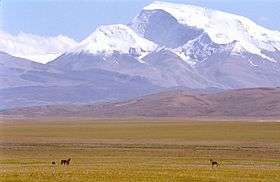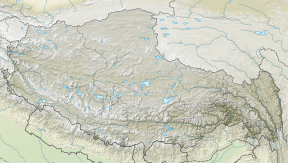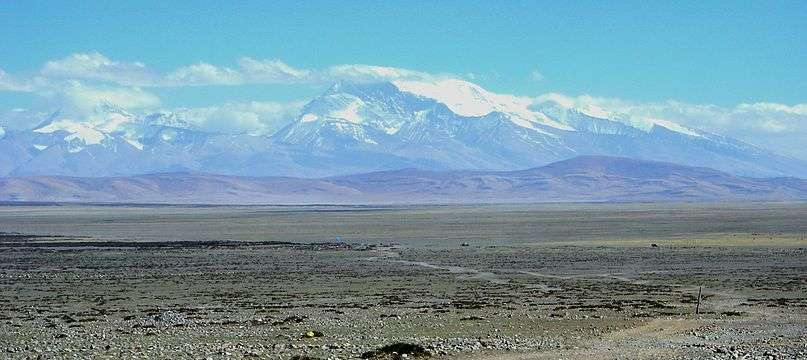Gurla Mandhata
| Gurla Mandhata | |
|---|---|
 Gurla Mandhata | |
| Highest point | |
| Elevation |
7,694 m (25,243 ft) [1] Ranked 34th |
| Prominence | 2,788 m (9,147 ft) [1] |
| Listing | Ultra |
| Coordinates | 30°26′09″N 81°17′45″E / 30.43583°N 81.29583°ECoordinates: 30°26′09″N 81°17′45″E / 30.43583°N 81.29583°E [1] |
| Geography | |
 Gurla Mandhata Location in southwestern Tibet | |
| Location | Tibet, China |
| Parent range | Nalakankar Himal, Himalaya |
| Climbing | |
| First ascent | 1985 by Cirenuoji, Jiabu, Jin Junxi, K. Matsubayashi, Song Zhiyu, K. Suita, Y. Suita, T. Wada[2] |
| Easiest route | West flank: snow/ice climb |
Gurla Mandhata, or Naimona'nyi or Memo Nani(Chinese: 納木那尼峰) is the highest peak of the Nalakankar Himal, a small subrange of the Himalaya.It is named after king Mandhata of suryavansha of Ikshvaku dynasty. It lies in Burang County of the Ngari Prefecture in the Tibet Autonomous Region of China, near the northwest corner of Nepal. It is the 34th highest peak in the world (using a 500-metre prominence cutoff). It is also notable for being well within the Tibetan Plateau (most peaks of similar height - except notably Shishapangma, the world's 14th highest peak - lie nearer to or outside the edge of the Plateau) and relatively far away from other peaks of height greater than 7500 metres. It sits roughly across Lake Manasarowar from the sacred peak of Mount Kailash. The Tibetan name, Naimona'nyi, is said to come from naimo = "herbal medicine", na = "black", nyi = "heaped-up slabs", giving "the mountain of heaped-up slabs of black herbal medicine."[3]
Climbing history
In 1905 T. G. Longstaff, accompanied by two alpine guides and six porters, made an attempt on Gurla Mandhata. They turned back at around 7,000 m (23,000 ft) after being caught in an avalanche and encountering other difficulties.[2] This was a strong achievement for the time, especially for such a small group; at that time no summit of over 7,000 m had yet been climbed and Longstaff's height represented a world altitude record.
In 1955 the mountain was the intended destination of the inaugural Welsh Himalayan Expedition, led by Sydney Wignall.[4] The expedition, sponsored by the Liverpool Daily Post, intended to summit Gurla Mandata and plant three flags: the Welsh Dragon, the flag of the recently-overthrown Chinese Republic and the Jolly Roger.[4] Before the climb could begin, the group was captured by the Chinese military who imprisoned and tortured the climbers for two months under the belief they were CIA spies (Wignall had in fact offered to spy for India).[4]
The first ascent of the peak was by a joint Japanese/Chinese team led by Katsutoshi Hirabayashi, via the north side of the peak, in May 1985.[3] Since that time, there have been six additional successful ascents and two failed attempts on the peak.[5]
In 1997, an attempt was made to ascend the peak via the then-unclimbed North Face route by Quinn Simons, Soren Peters, and their guide, Charlie Fowler. The team made a valiant effort, climbing high on the mountain, but after severe storms and other difficulties had to retreat. Their descent ended in a fall of some 450 m (1,500 ft) down the North Face of the peak. Fowler was slightly injured, while Simons and Peters both suffered extreme frostbite on their extremities.[6]
The standard ascent route climbs the western flanks of the mountain ascending the Chaglung'mlungha Glacier to the summit plateau. Most teams choose to approach the mountain over land by jeep from either Lhasa, Tibet, or Kathmandu, Nepal. However, an alternate approach begins in the mountain hamlet of Simikot, Nepal, in the remote Humla district of west Nepal and follows the Karnali River northward, crossing into Tibet (China) in the village of Sher. Jeeps then take climbers north through Taklakot (Burang) to basecamp on the mountain.
References
- 1 2 3 "China I: Tibet - Xizang". Peaklist.org. Retrieved 2014-05-29.
- 1 2 Jill Neate, High Asia, The Mountaineers, 1989.
- 1 2 American Alpine Journal 1986, p.302.
- 1 2 3 "Obituaries: Sydney Wignall". The Daily Telegraph. London: Telegraph Media Group. 25 April 2012. Retrieved 28 December 2017.
- ↑ The Alpine Club's Himalayan Index (accessed 2007-07-21) lists five ascents and two failed attempts through 2001. The American Alpine Journal records no ascents or attempts from 2002 through 2005. The Expedition blog of the First American ascent of Gurla Mandhata records the only other ascent, in 2006. (There is some possibility of unrecorded ascents or attempts, so these numbers may be slight underestimates.)
- ↑ American Alpine Journal 1999, pp. 211-213.
External links
- A list of prominent Asian peaks
- Digital Elevation Data (Go to n30e081)
- Historical photo of Gurla Mandhata with Mount Kailas taken from Lipu Pass, on a NASA-related site
